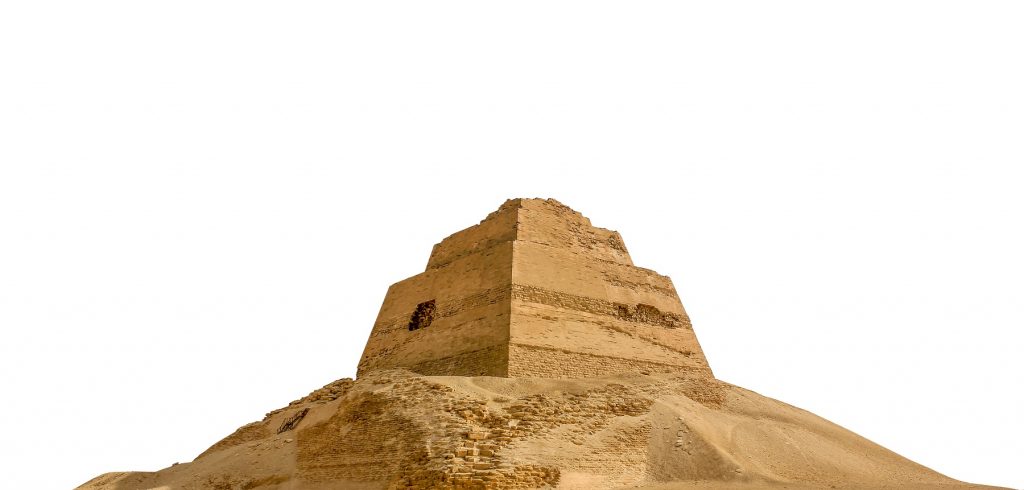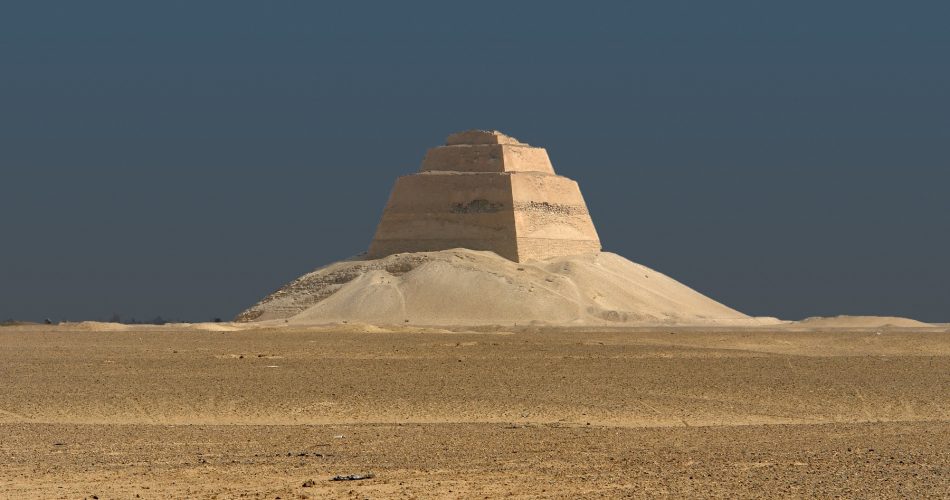In ways more than one, Egypt’s pyramid at Meidum is a complete mystery to experts. Not only because it represents a transition in Egypt’s pyramid building technique, but because out of approximately 120 pyramids, it is one of the most unique. Embedded within the puzzles of this ancient pyramid and its surrounding necropolis are distant events that directly influenced Egypt’s Archaic monuments, shaping them into their classic, Old Kingdom monuments. In other words, the pyramid at Meidum plays a crucial role in our understanding of Egypt’s pyramid-building history.
It is believed that Egypt’s first pyramid was that of Djoser, constructed during Egypt’s Third Dynasty. This was, according to mainstream accounts, approximately 4,700 years ago. The monument, Saqqara’s Step Pyramid, is regarded as the first ancient wonder constructed in the land of the Pharaohs. It revolutionized Egypt’s architecture in more ways than one. The pyramid is the central piece of Djoser’s Pyramid complex, which is estimated to be about 2.5 times as large as the Old Kingdom town of Hierakonpolis.
The story behind the Pyramid of Meidum
According to Manetho, when Sneferu came to the throne around 2,575 BC, Djoser’s was the only large royal pyramid that stood complete in ancient Egypt.
After Djoser, Pharaohs of the third dynasty attempted in replicating what their predecessor had accomplished, but their pyramid complexes were never complete. Examples are the buried pyramid of Sekhemkhet, and the Layer Pyramid of Zawiyet el-Aryan.
With Sneferu came Egypt’s second completed pyramid. The Fourth Dynasty ruler would become the greatest pyramid-builder in the history of ancient Egypt and successfully completed three massive pyramids. Egyptologists credit Sneferu with having built the pyramid at Meidum, and the Red and Bent pyramid at Dahshur. He is also credited with building a smaller pyramid at Seila.
In total, Sneferu’s pyramids surpass in a mass of stone even the Great Pyramid of Giza, thought to have been built by his son Khufu.
Similar to Djoser’s Step Pyramid, Medium was constructed in various different stages. In this way, we can say that Sneferu’s pyramid at Meidum was another Proto-Pyramid. Sneferu’s pyramid at Meidum is thought to have started off as a step pyramid consisting of seven distinct steps. In total, the pyramid is thought to have been completed in three stages. This stage is known among archaeologists as E1.
Before the builders finished the fourth (or fifth) step of Meidum’s pyramid, the pyramid was enlarged adding another step to the structure, now totaling eight steps. This stage is known as E2 and is thought to have been completed in Sneferu’s first 14 years of reign.
During Sneferu’s 15th year as King of Egypt, his court was moved to the Royal Necropolis of Dahshur where new projects were planned. During this time, a change in the pyramid design appeared, and Sneferu orders his royal architects to return to Meidum and turn the Step Pyramid into a smooth-sided, true pyramid. This stage is known as E3.

This is one of the main reasons why Meidum’s pyramid is so unique; it represents the very beginning and end of Sneferu’s pyramid-building program.
Today, like many other pyramids in Egypt, Meidum bears only a small part of its former glory. Instead of the eight steps the pyramid had when it was completed, the present-day structure consists of a three-stepped tower, rising above a sloping mound of debris. Egyptologists assume that the three-stepped tower was left after the outer casing and packing that filled the steps of the pyramid were quarried away in antiquity. As noted by Lehner, Petrie recorded that the pyramid was still used as a quarry in his day.
However, another, perhaps far more plausible theory, is that the debris are the result of the collapse of the pyramid white it was under construction, after all the pyramid may have been a proto-pyramid; an experimental structure where the builders tested out its shape and form. Lehner believes this was not the case as excavations around the pyramid have not yielded any 4th-dynasty ropes, timbers, or materials, which discounts the theory the pyramid suddenly collapsed. However, this does not mean that after the pyramid was completed, it collapsed due to its experimental shape.
The Pyramid at Meidum was built with construction techniques introduced by Djoser in the Third Dynasty, with accretions of stone courses laid at an inward slope. However, better quality stones which were laid in more regular courses were used for the outer faces of the accretions, and fine white Tura limestone was built onto the other surface of the pyramid.
Interior
The inside of Meidum’s pyramid also features an important architectural mark. Its interior arrangement is innovative and one that would become standard in later pyramids. The builders of the pyramid constructed a long passage from near the center of the northern face of the pyramid, leading to the alleged burial chamber.
However, unlike the Step Pyramid, Sneferu’s pyramid at Meidum did not feature a vast subterranean world beneath the monument. (Djoser’s pyramid has a massive underground labyrinth spanning approximately 5.7 kilometers in length, composed of hundreds of rooms)
The builders of the pyramid at Meidum worked to and built the lower part of the passage in an open trench which was cut into the ground and filled with packing. This, according to Egyptologist, is not unusual, but they built the chamber at an approximate desert surface level and extended the narrow passage, which descended from the entrance, up into the very center of the pyramid.
Evidence that the pyramid of Meidum was indeed an experimental pyramid is seen in how the builders looked into creating a central room within the pyramid’s central part. Instead of using massive granite beams like those inside Djoser’s Pyramid, Sneferu’s architects made use of a technique of corbelling for the first time, placing each course of blocks above a certain height projecting inwards until both the walls met at the center.
It is noteworthy mentioning that no traces of a sarcophagus belonging to Sneferu have ever been found inside this pyramid, although Petrie recovered the remnants of a wooden coffin of the “early plain style” at the bottom of the pyramid’s shaft.

